Introduction
Patients who receive high dose cytarabine (doses of 1 g/m2 or greater) have significant incidence of:
- Neurotoxicity (7% to 28% incidence of neurotoxicity);
- Keratitis;
- Possible dose-limiting myelosuppression (Szoch & Kaiser, 2015; Alsdorf et al., 2016).
High dose cytarabine means assessment and documentation practices differed among nurses and physicians.
Practicum purpose:
- Formulating an evidence-based nursing assessment of neurological side effects of high doses of Cytarabine.
High doses of cytarabine (doses of 1 g/m2 or greater) are usually associated with keratitis, possible dose-limiting myelosuppression and irreversible 7% to 28% incidence of neurotoxicity (Szoch & Kaiser, 2015), as well as ascending, irreversible paraplegia (Alsdorf et al., 2016). High dose errors could emanate from different assessment and documentation practices among nurses and physicians. The purpose of this practicum is to formulate an evidence-based nursing assessment of neurological side effects of high doses of Cytarabine. Prior to the practicum, the focus on is on needs assessment.
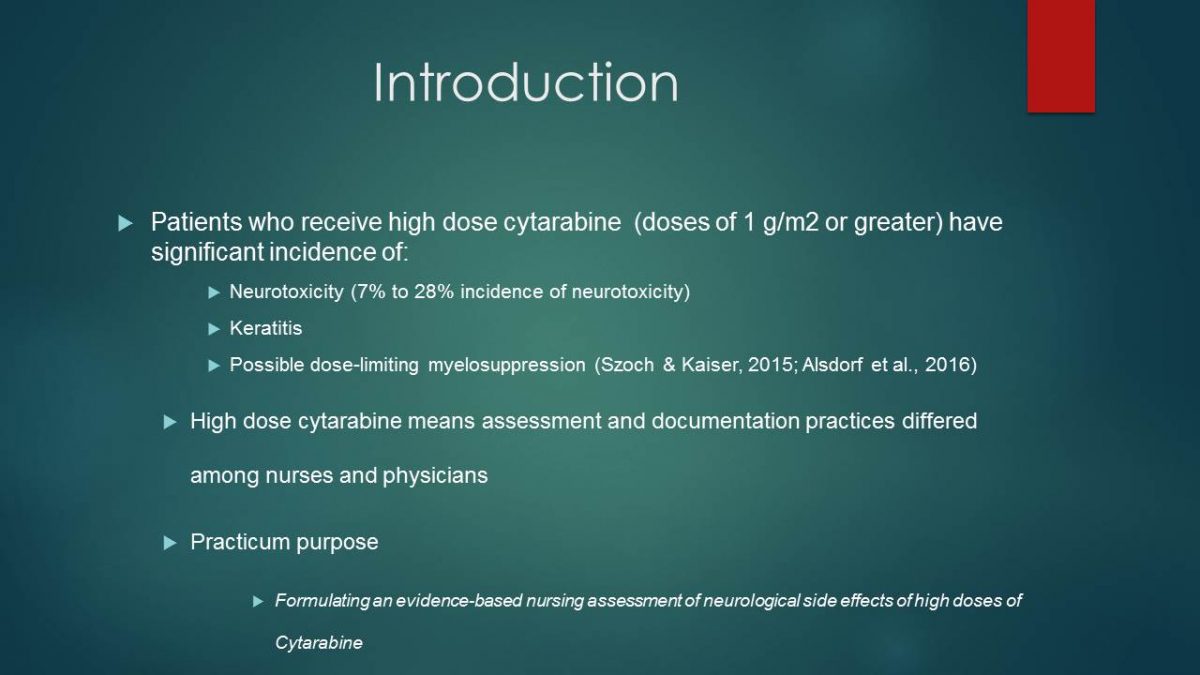
The role of the nurse educator in conducting a needs assessment
- Gap identification between current practices and best evidence-based practices (Anthony J. Jannetti, Inc, 2012);
- A content expert;
- Improving educational activities;
- Assessment of educational activities on outcomes (American Nurses Credentialing Center, 2014).
The main purpose of a needs assessment is a gap identification (Anthony J. Jannetti, Inc, 2012). A nurse educator plays a critical role in identifying these gaps, specifically between current practices and best evidence-based practices. Moreover, a nurse educator is considered as a content expert who can identify the need for needs assessments to improve educational activities to meet the learning needs of registered nurses and plan interprofessional education programs for improving team performance and patient outcomes (American Nurses Credentialing Center, 2014).
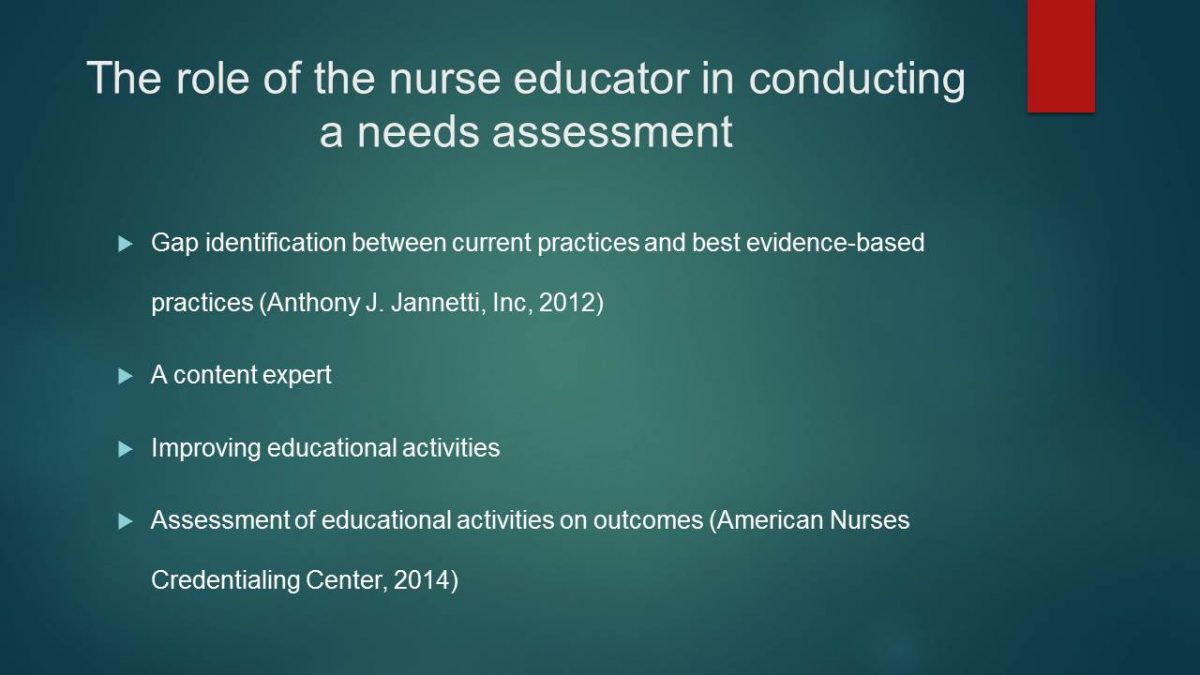
The use of a needs assessment when developing curriculum related to an evidence-based nursing assessment of neurological side effects of high doses of Cytarabine
- Needs assessment for evaluating more successful practices and areas for replication.
- Evaluating less successful areas: Inexplicit and inconsistent practices.
- Identifying practices to advance change (American Nurses Credentialing Center, 2014).
- Stakeholder identification:
- Nurse;
- Pharmacists;
- Physicians;
- Patients (American Nurses Credentialing Center, 2014).
- Assess the need for change and change management plan.
- Stakeholders are critical data points and sources.
The role of a needs assessment is to identify evidence-based practices that are more successful in nursing assessment of neurological side effects of high doses of Cytarabine. These practices can be used to improve current less inexplicit and inconsistent practices that lead to high doses of Cytarabine and toxicity.
A needs assessment would help to advance change through evidence-based practices, research, literature, and clinical guidelines for care.
Obviously, a needs assessment is aimed at improving processes, practices, and eventually clinical outcomes. As such, patients, nurses, and pharmacists, and physicians are most likely to be affected by new efforts to reduce neurological side effects associated with high doses of Cytarabine. Change management is therefore an imperative component of a needs assessment. Besides, this process helps in identifying relevant sources of information for assessment (American Nurses Credentialing Center, 2014).
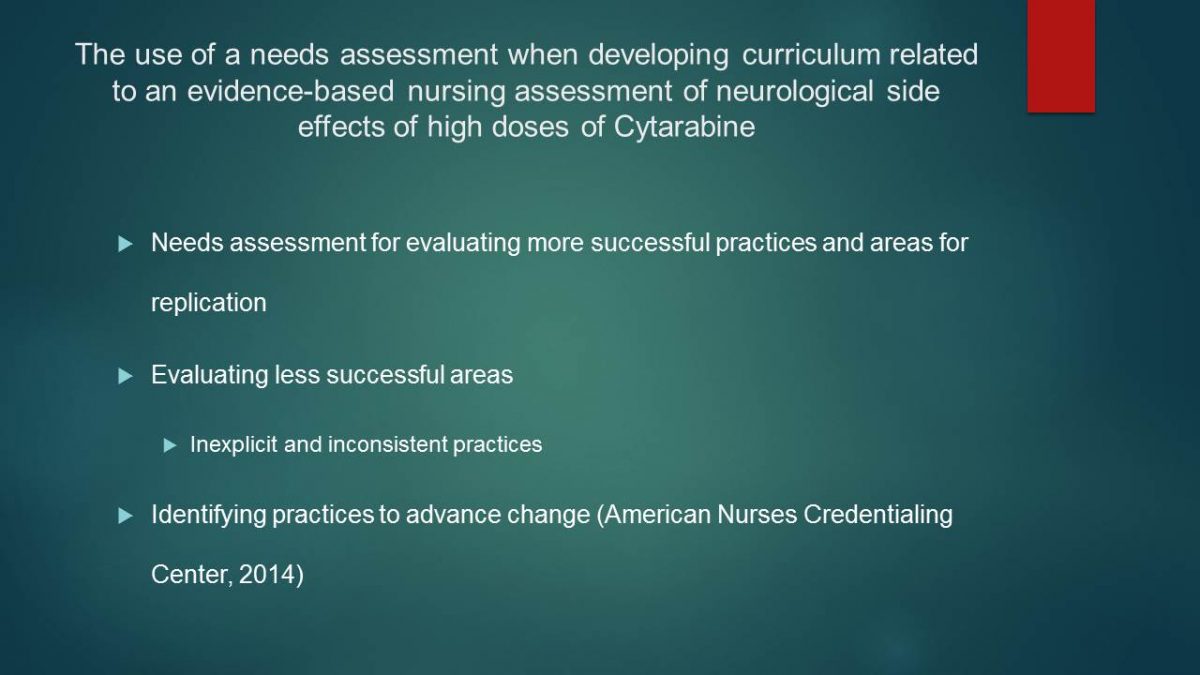
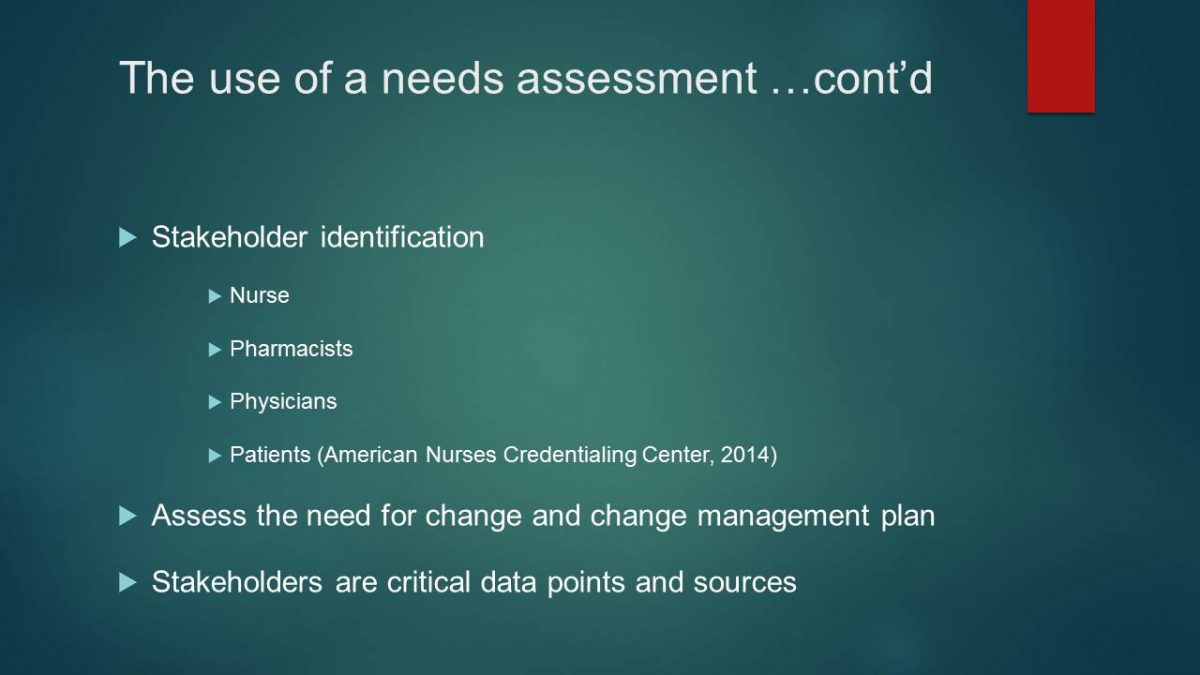
The types of data to be collected and how it relates to student characteristics and the learning environment
- Assessment and documentation practices:
- Risk factors associated with neurotoxicity and use of high dose cytarabine (Szoch & Kaiser, 2015).
- Recognizing neurological symptoms:
- How to perform assessments of cerebral status.
- Timely intervention to reduce complication:
- Document adverse assessment findings.
- Data on nurse documenting adverse assessment findings.
- Documentation practices.
- Knowledge on assessment to perform.
- Variation in practices.
- Inconsistent information regarding neurologic assessment to perform: The use of a standardized neurologic assessment guide and form (American Nurses Credentialing Center, 2014).
- Data collection tool designed for nurses, physicians, pharmacists, and administrators will be used to collect data on an evidence-based nursing assessment of neurological side effects of high doses of Cytarabine (McCawley, n.d).
The type of data for collection will generally target high doses of Cytarabine and possible risk factors and interventions (Szoch & Kaiser, 2015). Data should focus on assessment and documentation practices among nurses, physicians, and pharmacists because risk factors associated with the neurotoxicity and use of high dose cytarabine emanate from assessment and documentation practices that differed among nurses and physicians.
In addition, data will be collected on nurses’ abilities to recognize neurological symptoms and to perform assessments of cerebral status, as well as timely interventions to reduce cases of long-term side effects.
These data are aimed at presenting evidence-based practices for students to ensure that they understand consequences of poor assessment and documentation, relate knowledge to assessment performance, and observe variations in assessment and documentation practices among nurses and physicians. In addition, data would assist students to identify possible inconsistency and inexplicit documentation. Finally, data should allow students to understand the relevance of standardized neurologic assessment guide and documentation while looking for perceived solutions.
Data will be collected using written surveys. The survey would allow the assessor to reach many respondents as the hospital (McCawley, n.d).
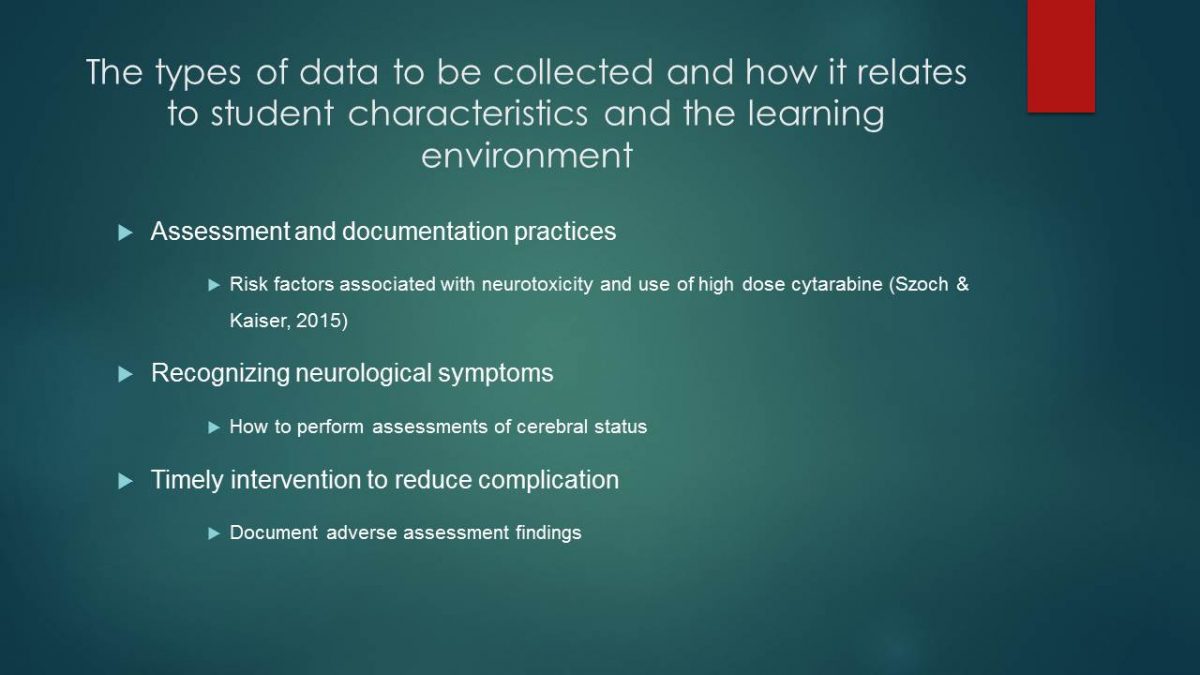
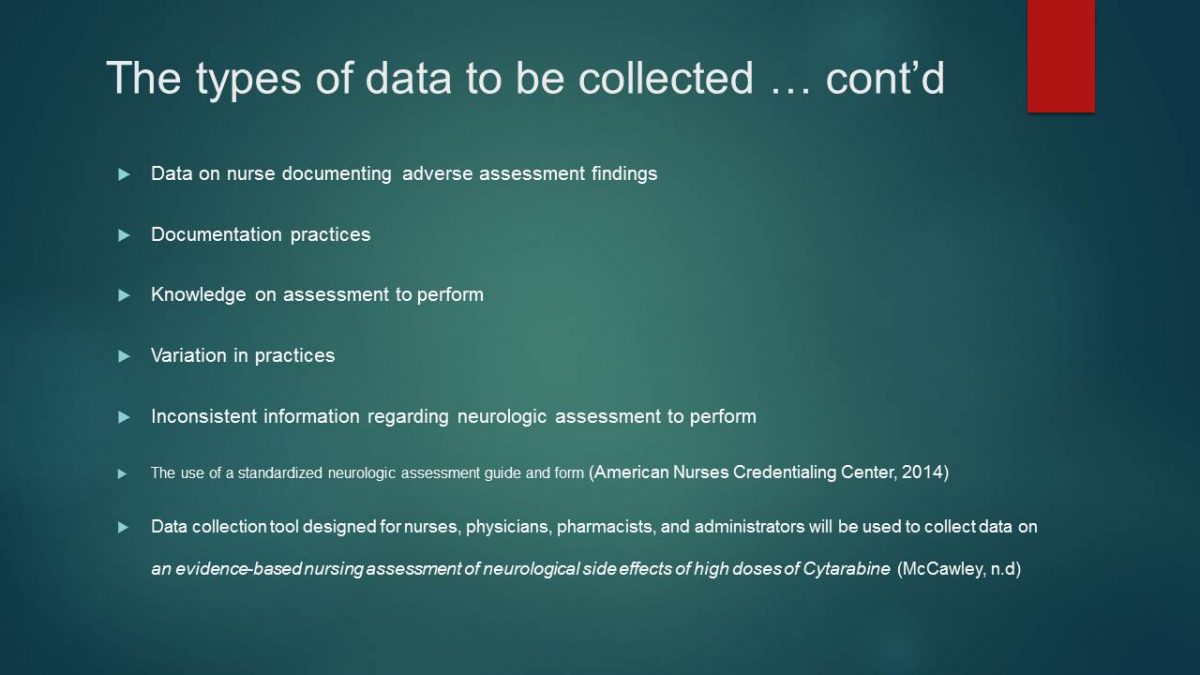
The process of developing a needs assessment
Needs assessment concentrates on:
- Target audience identification;
- Data resources and the relevant data points for collection;
- Data quality and relevance;
- Data collection, review and analysis;
- Review needs assessment findings (gaps);
- Presenting the report (Anthony J. Jannetti, Inc, 2012);
- Identify the gap between current practices and best practices;
- Determine gap in knowledge, skills, and/or practice;
- Identify purpose of the needs assessment;
- Develop a course;
- Implement the activity;
- Assess the activity (Anthony J. Jannetti, Inc, 2012).
A needs assessment development process needs a methodical approach that focuses on data resources and the relevant data points for collection. It ensures that collected data are useful to assessors. The collected data should be reviewed and analyzed to get important insights for the study. The findings represent gaps in knowledge, skills, and/or practice, which the assessor should strive to find the best solutions to mitigate negative outcomes on patients and nursing practices (Anthony J. Jannetti, Inc, 2012).
Once the gap has been identified, the subsequent processes generally aim at closing the gap by finding the best solutions. The most important aspects of solutions should focus on improving the current practices using the best evidence-based options (Anthony J. Jannetti, Inc, 2012).
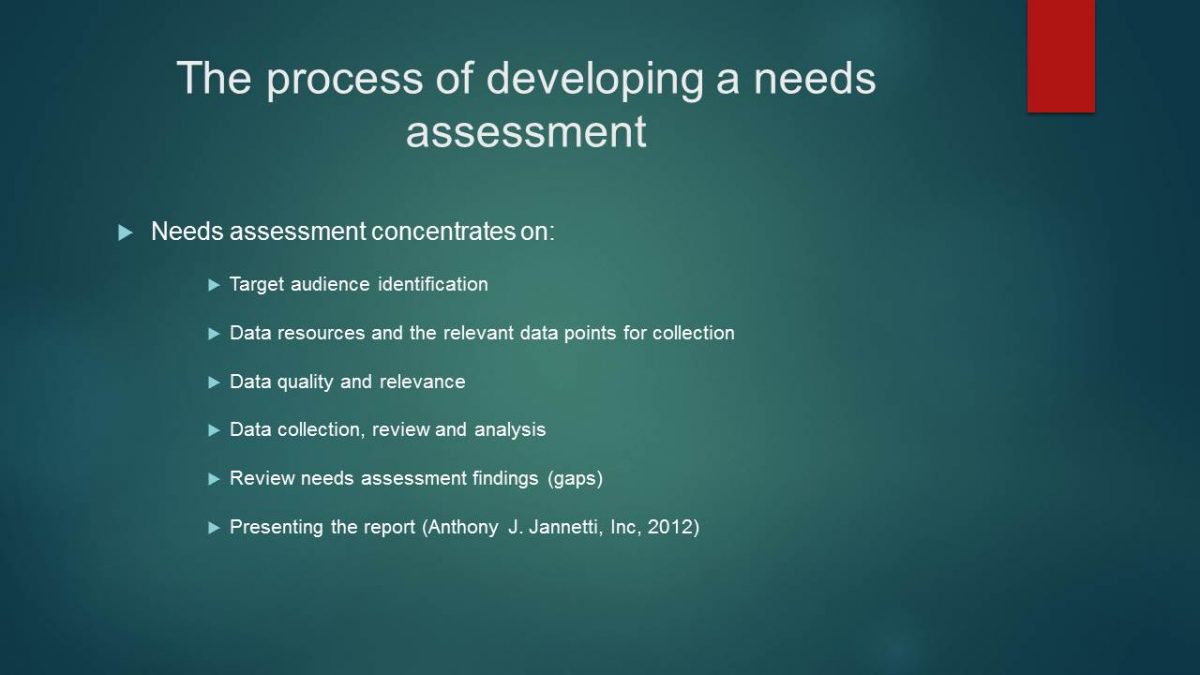
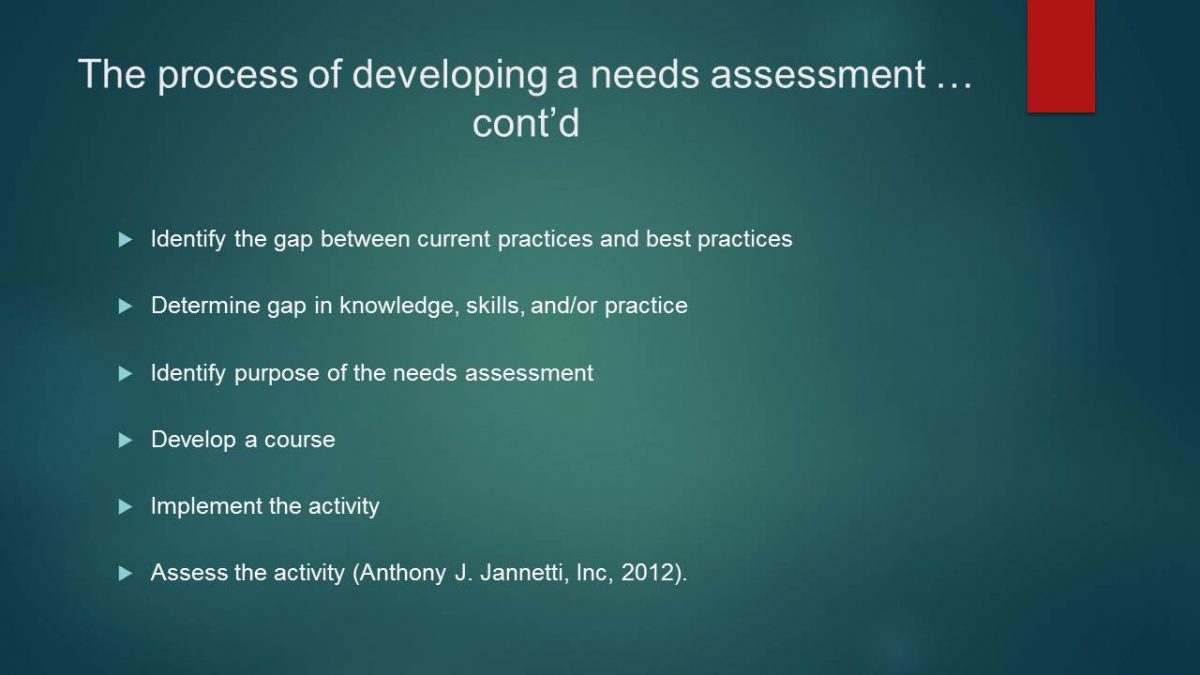
How open-ended and close-ended questions will elicit the information needed for needs assessment
Open-Ended Questions
Qualitative data for gaining insight on all the opinions on Formulating an evidence-based nursing assessment of neurological side effects of high doses of Cytarabine.
Closed-Ended Questions
- Generate easily quantifiable data;
- Data will prove the statistical significance;
- Assist in categorizing respondents into groups based on responses (McCawley, n.d).
In this practicum needs assessment, both open-ended and closed-ended questions are formulated to gather qualitative and quantitative data respectively. Overall, these questions are designed to assess different data sources and points to collect relevant information for needs assessment. They include important themes; nurse, physicians, and pharmacist involvement; resources; standard guides; and perceived solutions among others (McCawley, n.d).
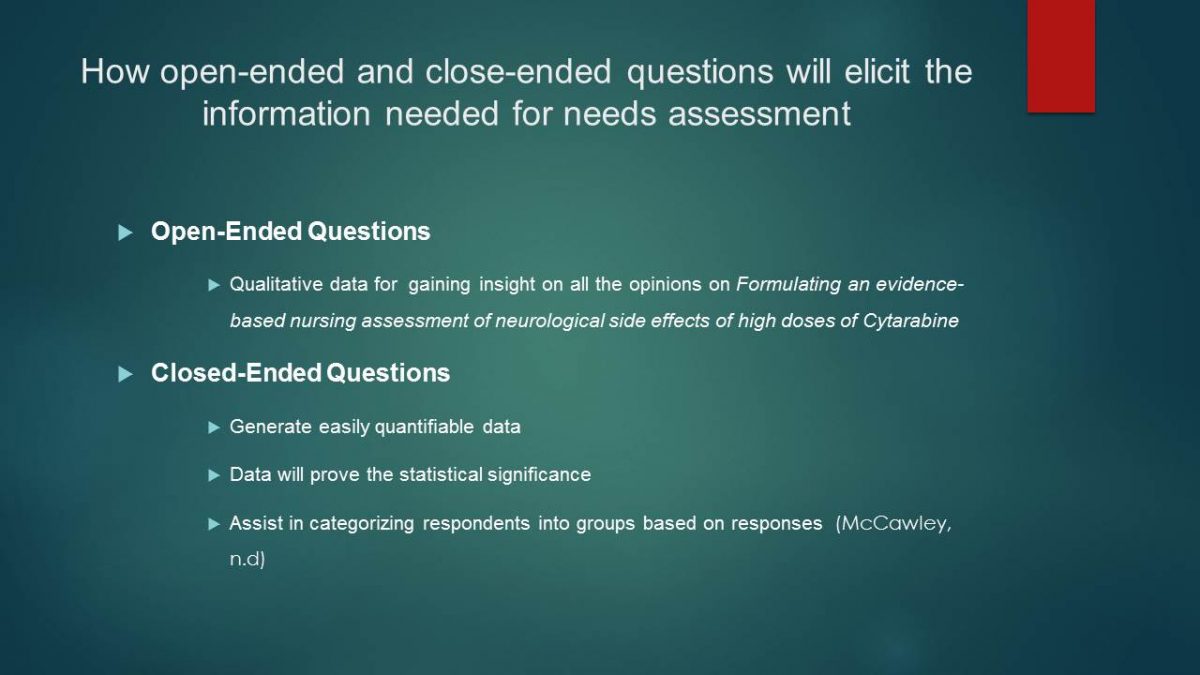
Any issues anticipated with collecting data, and a plan for mitigating these issues
Outcome measure may fail in:
- Reliability: A score or other measure remains unchanged upon test and retest;
- Validity: Measure assesses what it was intended to measure.
Mitigation:
- Understand principles of reliability and validity as they are used to ultimately evaluate the impact of a needs assessments on the professional practice of nursing, interprofessional team performance, and patient care;
- The instruments must be tested for reliability and validity (American Nurses Credentialing Center, 2014).
Irrespective of the outcome measure used, the assessor may encounter reliability and validity issues. The preferred outcome measurements should incorporate aspects of reliability and validity. In this case, validity and reliability will be established by conducting prior tests on data collection instruments (American Nurses Credentialing Center, 2014). This would ensure that data collected are reliable and valid, and they can therefore be used to assess professional nursing practices, multidisciplinary team performance, patient care, and perceived solutions to reduce neurological side effects of high doses of Cytarabine.
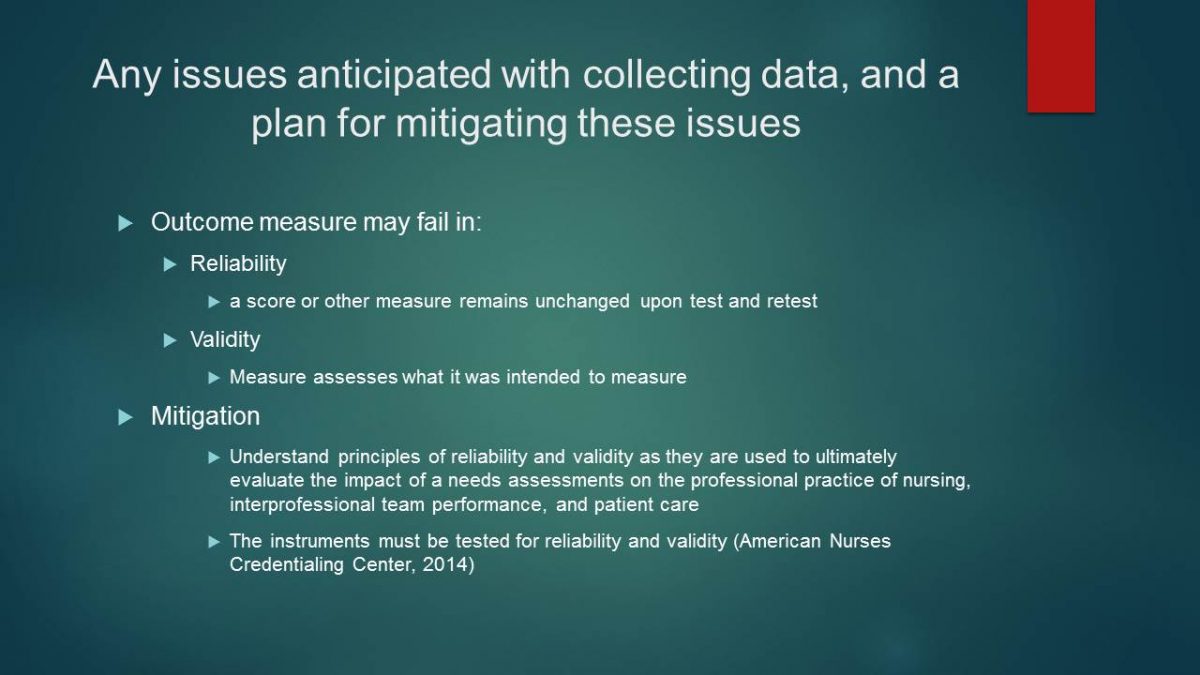
References
Alsdorf, W. H., Schmitz, M., Schieferdecker, A., Dierlamm, J., Bokemeyer, C., & Binder, M. (2016). Severe and irreversible myelopathy after concurrent systemic and intrathecal nucleoside analogue treatment for refractory diffuse large B-cell lymphoma: A case report and review of the literature. Journal of Oncology Pharmacy Practice, 22(3), 523-527.
American Nurses Credentialing Center. (2014). The Importance of Evaluating the Impact of Continuing Nursing Education on Outcomes: Professional Nursing Practice and Patient Care. Web.
Anthony J. Jannetti, Inc. (2012). A Representation: Incorporating a Needs Assessment and Gap Analysis into the Educational Design. Pitman, NJ: Anthony J. Jannetti, Inc.
McCawley, P. F. (n.d). Methods for Conducting an Educational Needs Assessment. Web.
Szoch, S., & Kaiser, K. S. (2015). Implementation and Evaluation of a High-Dose Cytarabine Neurologic Assessment Tool. Clinical Journal of Oncology Nursing, 19(3), 270-2.